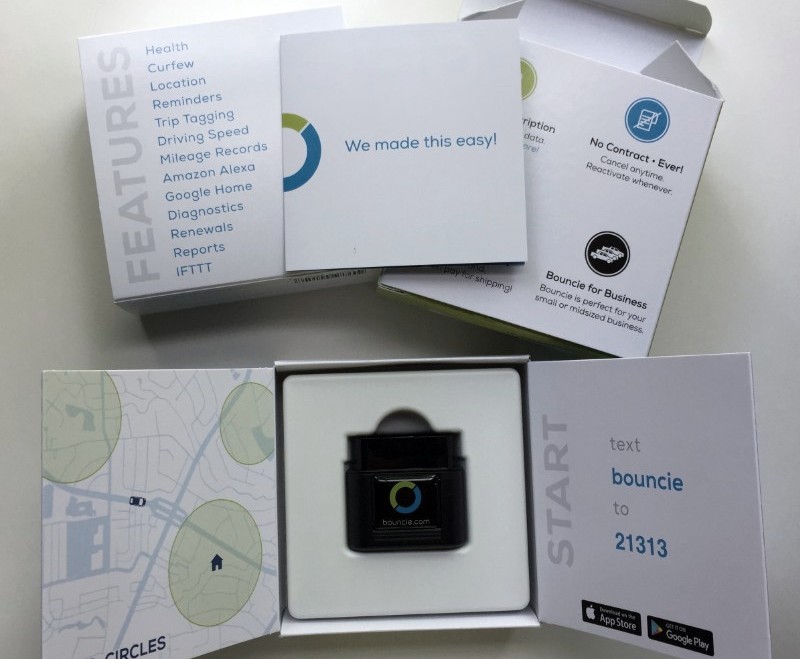Overall Rating
- Real-time GPS tracking
- Customizable notifications
- Alert delays
- Monitoring starts at $8/mo.
Bottom Line: Best Month-to-Month Option
The Bouncie device works a lot like other port-based GPS trackers: just plug it into your OBD port (the on-board diagnostics port under your dashboard) and it will start to track your car’s location. It uses a cellular connection to send trip data to your smartphone via AT&T’s 3G network, just like the similar GPS tracker Vyncs. It had some occasional two- to five-minute delays in transmitting data, but overall we found the connectivity to be good. Plus, it recently added crash detection to its features—something we felt was sorely lacking before.
Pros
- 15 second location refresh
- Easy installation
- No batteries needed
- Alexa, Google, and IFTTT compatibility
- Geofencing alerts
- Crash detection
Cons
- Delayed notifications
Bouncie Pricing
| Monthly Cost |
| Equipment Cost |
| Trial Period |
| Contract |
| Home Automation Features |
| Standout Features |
| $8 |
| $67 |
| 45 days |
| None |
| Compatible with Amazon Alexa, Google Home, IFTTT |
| Vehicle maintenance alerts Free roadside assistance 15 second location refresh |
| View on Bouncie |
Compared to similar OBD-port GPS car trackers, Bouncie falls in the middle range when it comes to price. It strikes a good balance between its competitors with a slightly higher initial device cost but no activation fee, a low monthly subscription fee, and no long-term contracts.

A glimpse at what the Bouncie looked like when we unboxed it.
Smart Home Integration
Bouncie stands out from the competition when it comes to compatibility with smart home technology. It’s compatible with Amazon Alexa, Google Home, and IFTTT (If This, Then That), but we found the IFTTT to be the most useful. You can use IFTTT applets to do things like turn on lights when you arrive home or turn off your security system. You can also set it up to change your smart thermostat settings when your vehicle leaves the house to help you save on energy costs.
We weren’t very impressed with the Alexa and Google connection just because there aren’t a lot of useful commands you can use. Probably the most useful command is “Alexa, ask Bouncie ‘Do I need gas?’” so you don’t have to run out to your car and turn it on to check. But Bouncie’s fuel tracking function works only with cars that send that information to the OBD port, and the 2014 Toyota Sienna we used to test the Bouncie was not one of them. Other commands include things like “Where is my car?” and “How far did I drive this month?”
Installation and Setup
Bouncie installation is a breeze—you just plug it in—but we do recommend setting up your account on your phone while you’re in your car, because it asks you for information like your VIN number and mileage. Keep in mind that the Bouncie needs a few trips to get its bearings before it can start sending you trip data, so be patient.

Bouncie plugged in to our tester’s car.
App and Features
The Bouncie mobile app is intuitive and easy to use. It saves trip data so you can review it at your convenience and then either archive or delete it. The app also lets you customize all the different things the GPS tracks:
- Maximum speed
- Rapid acceleration and hard braking
- Driving distance
- Idle time
- Fuel economy
- Speed bands
- Speed Limit Alerts
- Geofencing
Bouncie refreshes the GPS location once every 15 seconds during a trip, and we found it to be more accurate and less glitchy than GPS phone tracking apps like Life360. The Bouncie can now tell you if your car went over the legal speed limit. It can also track approximately how fast it was going based on the five color-coded speed band settings. You can customize the speed bands to track whatever speed ranges you set, like green for speeds between 0 and 30 mph. Bouncie can alert you if your vehicle goes faster than a specific speed you choose, but it doesn’t send this information to your phone until after the vehicle is already parked.


What you’ll see on your phone when you’re using the app.
A common complaint with GPS trackers is that the accelerometer that tracks abrupt stops and starts is too sensitive. We like that the Bouncie has three different settings for hard braking and rapid acceleration: light, moderate, and excessive. We kept it on the moderate setting and it performed perfectly.
The vehicle health reports are limited to battery fuel levels (for certain cars), but the battery alert proved to be useful. It alerted me to a low battery when I was waiting for my daughter outside an event and my car was off. Sure enough, when I tried to start my car, it wouldn’t start. Fortunately, the notification from Bouncie gave me enough lead time to round up another vehicle for a jumpstart, and I was ready to go again before my daughter was finished with her event. Had I waited until it was time to leave to start the car, I would have been in for quite the surprise! Bouncie definitely saved the day.
If I hadn’t had been able to find a helping hand that day, I could have clicked the Assistance section of the app and used one of my three free roadside assistance requests included with the Bouncie service for the year. It covers jumpstarts, flat tires, gas, lockouts, and towing.
Customer Service
We really liked the Bouncie website’s Info Hub. It has helpful troubleshooting info and answers to almost any question you might have about your Bouncie. While we didn’t need to use the customer service during our Bouncie trial run, other customers say the representatives respond promptly and are friendly and helpful.
How Bouncie Stacks Up
My teenage son is about to start driving, and I’m seriously considering installing the Bouncie in his car. Its GPS location tracking is much more reliable than the free GPS phone tracking apps I’ve used in the past, and it doesn’t depend on my kid remembering to keep his phone charged. I like that the GPS refreshes every 15 seconds, compared to the MOTOsafety tracking device that refreshes only every three minutes.
The trip data records give us a good opportunity to talk about safe driving habits and to discuss close calls that I might not otherwise know about. I can also get my son into the habit of paying attention to insurance, inspection, and tag renewals. Plus, I like that he’d have access to roadside assistance if needed.
Bouncie has a small month-to-month payment, so there’s no long-term commitment like the one-year, up-front payment that Vyncs requires. If my son’s driving is up to par, then I can stop my Bouncie service without penalty and hold on to the device until my daughter is old enough to start driving. Overall, it’s a solid investment for both short-term and long-term use.
| Device Type |
| Price for First Year |
| Price for Successive Years |
| Contract |
| Standout Feature |
| Learn More |
| Bouncie | Vyncs | MOTOsafety |
| OBD port plug | OBD port plug | OBD port plug |
| $163 | $108.92 | $254.87 |
| $96 | $68.95 | $239.88 |
| None | 1 year | None |
| Smart home compatibility | Works in 177 countries | Driver safety report card |
| View on Bouncie | View on Amazon | View on Amazon |
Data effective 5/14/2019. Offers and availability subject to change.
FAQs
Is it legal to put a vehicle tracker on my teenage driver’s car?
Generally speaking, your best bet is to install location tracking devices only on vehicles you personally own. But in some states it is legal for a parent to put a tracking device on their minor child’s vehicle without their consent, even if the child owns the vehicle.1 Check your state’s laws if you’re not sure.
Will a vehicle GPS tracker work on a smart car?
Yes. Most smart cars have OBD ports under the steering columns just like regular cars do, so a GPS tracker should work just fine.
How is a GPS tracking device different from a GPS navigation device?
A GPS tracking device usually plugs into your OBD port and tracks your car’s movements. It sends the information to your phone. A GPS navigation device sits on your dash or attaches to your windshield with a suction cup mount and gives you audible directions to your destination.
Conclusion
We give Bouncie a thumbs-up for its product features, quality, usability, and price. The updates are sometimes a little slower than we’d like, but that seems to be the case with most GPS trackers out there, so we can’t complain. It has all the features you need to track your vehicle and monitor driving habits with no long-term contracts or pesky additional fees. We recommend it for any teen drivers and their parents who want some added peace of mind on the road.
How We Reviewed Bouncie
To review the Bouncie GPS tracker, we installed it in a 2014 Toyota Sienna and downloaded the mobile app to see how well it tracked the vehicle’s movements. We did some intentional hard braking and fast acceleration to test its accelerometer and played around with the different settings in the app. Our full methodology explains more about how we test and review devices like the Bouncie.
Sources:
- National Council of State Legislatures, “Private Use of Mobile Tracking Devices“
The post Bouncie GPS Vehicle Tracker Review appeared first on SafeWise.


No comments:
Post a Comment